Kate Weare Company and Liz Gerring Dance Company present New York seasons.
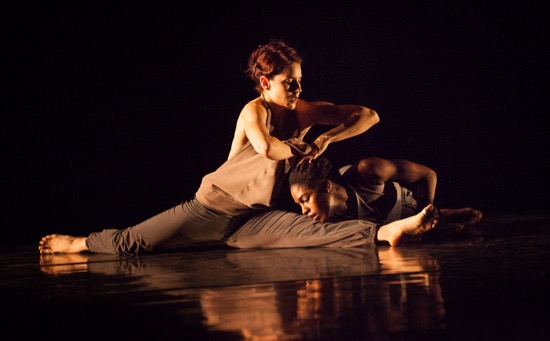
Nicole Diaz (L) and Kayla Farrish in Kate Weare’s Marksman. Photo: Yi-Chun Wu
It’s rare to see, on two adjoining nights, two hour-long dances by two gifted, highly original choreographers who were born and raised in California (a native Californian myself, I couldn’t resist throwing in that last commonality). The distinctive styles that Kate Weare and Liz Gerring have developed are nothing alike, yet several things about Weare’s Marksman at the Joyce Theater and Gerring’s (T)here to (T)here at the Baryshnikov Arts Center struck me as akin.
Both works have casts of six, three men and three women each. Neither tells a story. Both are performed to commissioned scores. On another level, both suggest small communities with their own diverse conventions and rituals. If the dancers look toward the audience, they don’t appear to see us; they peruse a horizon. Fascinated by the two works, I nevertheless found myself becoming slightly restless near the end of each. Perhaps this is because they’re like games whose rules and outcome we don’t know, or like rich fruitcakes, in which every slice is full of contrasting sweetmeats, but not that different from the next slice.
Weare’s Marksman is a development of her 2015 trio, Unstruck. It begins the same way, with two dancers, Nicole Diaz and Julian De Leon standing close together center stage in a pool of light (lighting design: Mike Faba). Curtis Robert MacDonald’s score (heard on tape) for saxophones, piano, electric guitar, acoustic bass, and melodica begins with a low groaning. At the rear of the stage, in Clifford Ross’s design, the slightly parted black backdrop reveals what could almost be a thin slice of dark forest against clouds. Diaz is arched back, her chest to the sky, her gaze upward. Why, you think, would anyone want to stand like that for this long? Julian De Leon shapes his body around her, against her, intersecting with her, as if trying—in a dreamy yet probing way— to sense what she’s like.
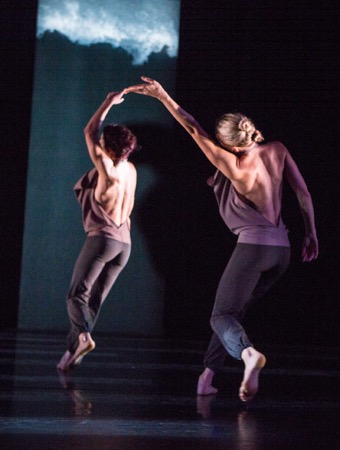
Nicole Diaz (L) and Thryn Saxon of Kate Weare Company in Marksman. Photo: Yi-chun Wu
This brief duet introduces qualities that pervade the work, through all the collaborations, the comings together, and the separations. Few dances are as sensual as Weare’s, yet standard embraces don’t play much of a role. Instead, you feel the intensity of the performers’ gaze, the way one might be investigating another’s scent or feeling the softness of his/her skin. In contrast to this kind of intimacy and yet in collusion with it, a dancer may unexpectedly flick a hand against another’s neck or push someone into a crouch. For the most part, struggle and sharp physical retorts arise from and return to tenderness. These people know one another’s sensitive spots, and sometimes those sly, almost offhand blows are almost shocking.
Another pair (Douglas Gillespie and Kayla Farrish) joins De Leon and Diaz onstage, but these two have their own ways of exploring how they might connect. As do Thryn Saxon and Ryan Roulard Smith. (All the dancers are credited as “creative collaborators,” and that may be one reason they move so fully and sensitively, both alone and together.)
It’s interesting the effect that a familiar structural element in dance has in this context. When two couples perform equally intimate duets in unison, you don’t think there’s been a stylistic turnaround, you just think, “so this is the way they live.” Or, “yes, certain ‘jobs’ require certain precise moves and tempos.”
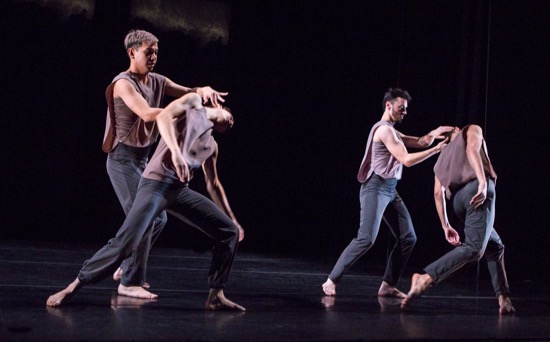
Kate Weare’s Marksman. (L to R): Julian De Leon and Nicole Diaz. Ryan Rouland Smith and Douglas Gillespie. Photo: Yi-chun Wu
Weare’s choreography for this sextet continues to explore the trio imagery she introduced in Unstruck. Arms around one another, two sets of three dancers lope around the space. De Leon and Smith crush Diaz between them, and the pressure propels her upward into a lift. However, all six clump up and pulse or jiggle. They lean together and droop. People keep leaving and returning. Sometimes furtive and not-so-furtive violence crops up. At a point when the vivid music is quaking and groaning, I write words like “head butt,” “wrench,” “sock,’ and (harder to detect) “pinch.” But much of the animosity happens on the run, or bubbles up and subsides in an ongoing flow of equanimity and vigorous movement. People not only struggle together; they aid or copy one another, and are there to catch someone who’s falling. They can become (briefly) one another’s project.
Wonderful performers all, Weare’s dancers generate a heat that seems to come from the glide and pressure and quick brush of skin against skin, and against the skein of air between moving bodies. In the end, Diaz is again arched back, but this time her arms are lifted in a V. Not for the first time, I think about the dance’s title, Marksman. How often, in life, are we precision shooters, in terms of setting our sights on what we think we want? Cupid’s arrows sometimes missed their targets too.
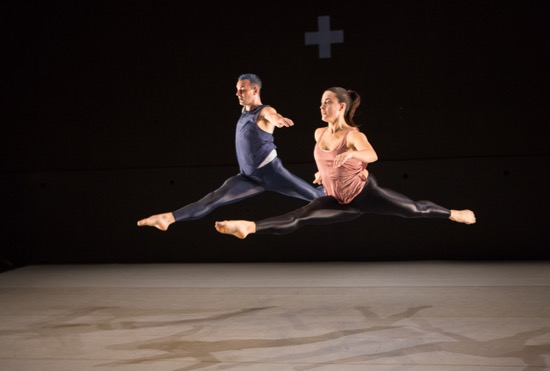
Brandon Collwes and Claire Westby in Liz Gerring’s (T)There to (T)here. Photo: Yi-chun Wu
There’s little that’s sensual in Gerring’s (T)here to (T)There (part of Lincoln Center’s White Light Festival), in terms of relationships among her dancers, but an animal heat builds up in the space. These six are indomitable, but vulnerable as they tire; more than the sweat that dampens their clothing tells us that. Almost everything they do is precise, linear, designed in relation to space. Yet many of their moves are strange, skewed in some way—such as walking forward while bending sideways. Claire Westby balances on one leg, with other sticking straight out in front of her, and slowly moves the horizontal leg back and forth; in a pre-computer era it would have resembled a compass needle seeking north. What’s it scanning now?
Gerring lets us get to know her dancers gradually. First Brandon Collwes dances alone; then Westby joins him. After some time, Joseph Giordano begins making entrances, fitting himself into the stage picture, then disappearing for a while. Julia Jurgilewicz arrives later still. Next comes Pierre Guilbault. Finally (a surprise if you haven’t read the program): Gerring herself.
She is not the sole creator of the enigmatically titled, (T)here to (T)There. The artist Kay Rosen has collaborated with the choreography, creating a spare dance of letters, shapes, and eventually colors on the backdrop (video set design by Joshua Higgison and lighting design by Amith Chandrashaker). For example big white letters, DVSBLT, oddly spaced out, are there when we enter the theater; gradually, they become DIVISIBILITI; then, gradually, the consonants drop out. A word like LEVEL appears vertically, with the final E and L turned backward as well. Much later in the dance, several small white oval rings drift downward. At one point, half the stage floor and back wall are blue, and half are red, while a giant yellow Y-shaped piece drops its tail down and across the floor to divide the two halves. When this occurs, Westby occupies one space and Collwes another, while Giordano hews to the line between. Toward the end, huge white rings descend the wall and slide toward the audience.
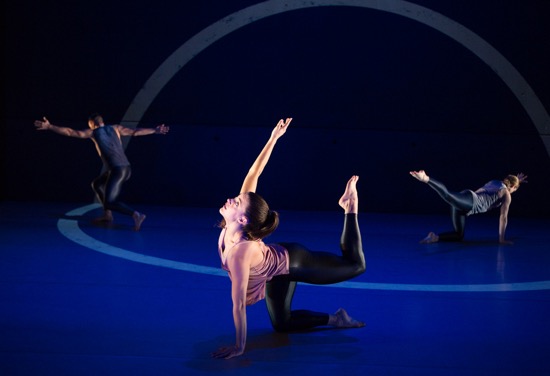
Kay Rosen’s design, Liz Gerring’s choreography. (L to R): Brandon Collwes, Claire Westby, and Julia Jurgilewicz. Photo: Yi-chun Wu
You could get a little crazy, keeping track of both the dancing and the visual designs, although it’s stimulating to try. Once, I link Giordano, lying on his side with his arms stretched overhead to the “=” sign in the projected equation. However, in a program note, Gerring warns us that, “[t]he words add a suggestion of context to the movement, not a description of what is happening. They are a colorization of the environment in which the dance takes place.”
Often the dancing seems to proceed in big gulps of strenuous, slashing movements, often separated by pauses. The kick of a leg may pull a dancer into a deep lunge. The flight of the performers’ leaps and the heft of their movements are amazing. They fall, roll, rise. How many times can they travel by jumping straight up, folding their legs under them? The sheen of their gray or electric blue tights (costumes by Quinn Czejkowski in collaboration with Gerring and Miguel Anaya) gives them a futuristic look. They could suggest a powerful civilization to come, but there’s nothing robotic about them. Watch Westby, standing on one leg beside (as I remember) Giordano, who’s lying prone; slowly, her eyes on him, she begins to bend that leg until she’s low enough to kneel on his back (that’s when the visual design first bursts into three colors, preparing the stage for Jurgilewicz and Guilbault to join the dance.
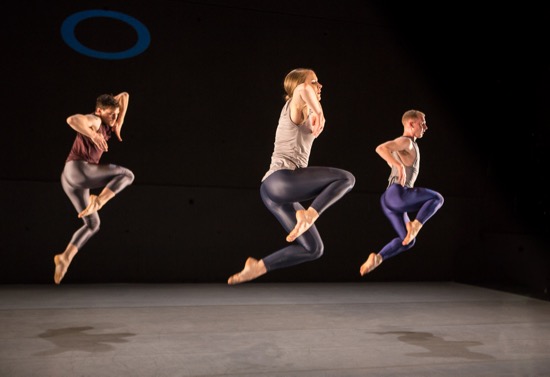
Liz Gerring’s (T)here to (T)here. (L to R): Pierre Guilbault, Julia Jurgilewicz, and Joseph Giordano jump for Liz Gerring. Photo: Yi-chun Wu
Sometimes these remarkable people notice one another; sometimes they seem to sense a colleague’s presence. It’s as if they have predetermined courses to follow, and only occasionally does one grab a fallen person’s hand and pull him/her up off the floor. Once, Westby is sitting, again using one leg like a pointer, and Collwes, crawling along a diagonal, passes right over her, as if he were leading a column of ants. When the dancers slip unexpectedly into unison, they seem almost to be following a program, rather than by making a personal decision.
Michael J. Schumacher’s electronic score emphasizes the oddity of moves that either distort ever so slightly what we expect, or insist on something uncomfortable. Yet the fact that these are intelligent, rampantly human individuals tugs powerfully at the demanding tasks they’ve been assigned. And—another “yet”—they are clearly members of a society that requires a degree of cooperation, along with the mastery of skills. You somehow know these extraordinary people—especially Westby and Collwes, who have been working on this material for several years—but at the same time, you do not know them. Nor does Gerring’s own late, decisive-dancing appearance mark her as the leader of this clan. They’re in a jungle of their own making, and you’d have to stick around for a while to understand what they live for.
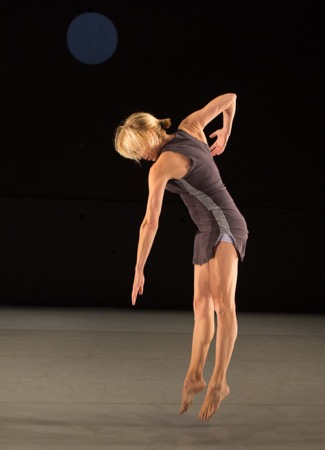
Liz Gerring in her and Kay Rosen’s (T)here to (T)here. Photo: Yi-chun Wu
Being at the Joyce the day after the election was an unsettling experience. There were more empty seats than you’d expect at an opening night. I hope Kate Weare understands that many were out protesting or at home mourning, and that those of us in the audience felt our spirits lift a little.
